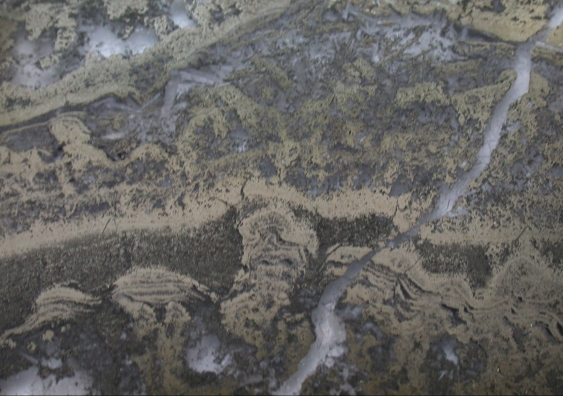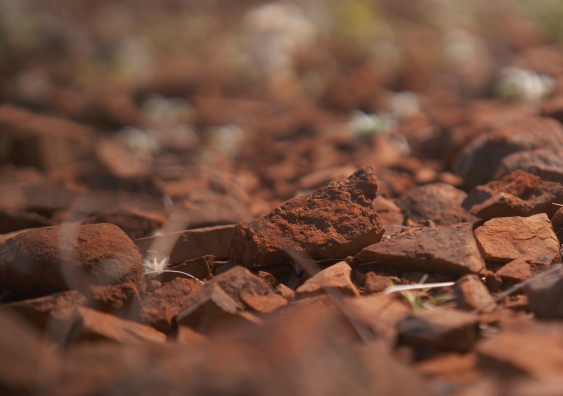Earliest signs of life: scientists find microbial remains in ancient rocks
Western Australia’s famous 3.5-billion-year-old stromatolites contain microbial remains of some of the earliest life on Earth, UNSW scientists have found.
Western Australia’s famous 3.5-billion-year-old stromatolites contain microbial remains of some of the earliest life on Earth, UNSW scientists have found.

Isabelle Dubach
Media and Content Manager
+61 432 307 244
i.dubach@unsw.edu.au
Scientists have found exceptionally preserved microbial remains in some of Earth’s oldest rocks in Western Australia – a major advance in the field, offering clues for how life on Earth originated.
The UNSW researchers found the organic matter in stromatolites – fossilised microbial structures – from the ancient Dresser Formation in the Pilbara region of Western Australia.
The stromatolites have been thought to be of biogenic origin ever since they were discovered in the 1980s. However, despite strong textural evidence, that theory was unproven for nearly four decades, because scientists hadn’t been able to show the definitive presence of preserved organic matter remains – until today’s publication in prestigious journal Geology.
“This is an exciting discovery – for the first time, we’re able to show the world that these stromatolites are definitive evidence for the earliest life on Earth,” says lead researcher Dr Raphael Baumgartner, a research associate of the Australian Centre for Astrobiology in Professor Martin Van Kranendonk’s team at UNSW.
Professor Van Kranendonk says the discovery is the closest the team have come to a “smoking gun” to prove the existence of such ancient life.
“This represents a major advance in our knowledge of these rocks, in the science of early life investigations generally, and – more specifically – in the search for life on Mars. We now have a new target and new methodology to search for ancient life traces,” Professor Van Kranendonk says.
Drilling deep, looking closely
Ever since the Dresser Formation was discovered in the 1980, scientists have wondered whether the structures were truly microbial and therefore the earliest signs of life.
“Unfortunately, there is a climate of mistrust of textural biosignatures in the research community. Hence, the origin of the stromatolites in the Dresser Formation has been a hotly debated topic,” Dr Baumgartner says.
“In this study, I spent a lot of time in the lab, using micro-analytical techniques to look very closely at the rock samples, to prove our theory once and for all.”
Stromatolites in the Dresser Formation are usually sourced from the rock surface, and are therefore highly weathered. For this study, the scientists worked with samples that were taken from further down into the rock, below the weathering profile, where the stromatolites are exceptionally well preserved.
“Looking at drill core samples allowed us to look at a perfect snapshot of ancient microbial life,” Dr Baumgartner says.
Using a variety of cutting-edge micro-analytical tools and techniques – including high-powered electron microscopy, spectroscopy and isotope analysis – Dr Baumgartner analysed the rocks.
He found that the stromatolites are essentially composed of pyrite – a mineral also known as ‘fool’s gold’ – that contains organic matter.
“The organic matter that we found preserved within pyrite of the stromatolites is exciting – we’re looking at exceptionally preserved coherent filaments and strands that are typically remains of microbial biofilms,” Dr Baumgartner says.
The researchers say that such remains have never been observed before in the Dresser Formation, and that actually seeing the evidence down the microscope was incredibly exciting.
“I was pretty surprised – we never expected to find this level of evidence before I started this project. I remember the night at the electron microscope where I finally figured out that I was looking at biofilm remains. I think it was around 11pm when I had this ‘eureka’ moment, and I stayed until three or four o'clock in the morning, just imaging and imaging because I was so excited. I totally lost track of time,” Dr Baumgartner says.

Rocks in the Pilbara - the home of the ancient stromatolites.
Clues for search for life on Mars
Just over two years ago, Dr Baumgartner’s colleague Tara Djokic, a UNSW PhD candidate, found stromatolites in hot spring deposits in the same region in WA, pushing back the earliest known existence of microbial life on land by 580 million years.
“Tara's main findings were these exceptional geyserite deposits that indicate that there have been geysers in this area, and therefore fluid expulsions on exposed land surface,” Dr Baumgartner says.
“Her study was focused on the broader geological setting of the paleo-environment – lending support to the theory that life originated on land, rather than in the ocean – whereas my study really went deeper on the finer details of the stromatolite structures from the area.”
The scientists say that both studies are helping us answer a central question: where did humanity come from?
“Understanding where life could have emerged is really important in order to understand our ancestry. And from there, it could help us understand where else life could have occurred – for example, where it was kick-started on other planets,” Dr Baumgartner says.
Just last month, NASA and European Space Agency (ESA) scientists spent as week in the Pilbara with Martin Van Kranendonk for specialist training in identifying signs of life in these same ancient rocks. It was the first time that Van Kranendonk shared the region’s insights with a dedicated team of Mars specialists – a group including the Heads of NASA and ESA Mars 2020 missions.
“It is deeply satisfying that Australia’s ancient rocks and our scientific know-how is making such a significant contribution to our search for extra-terrestrial life and unlocking the secrets of Mars,” says Professor Van Kranendonk.